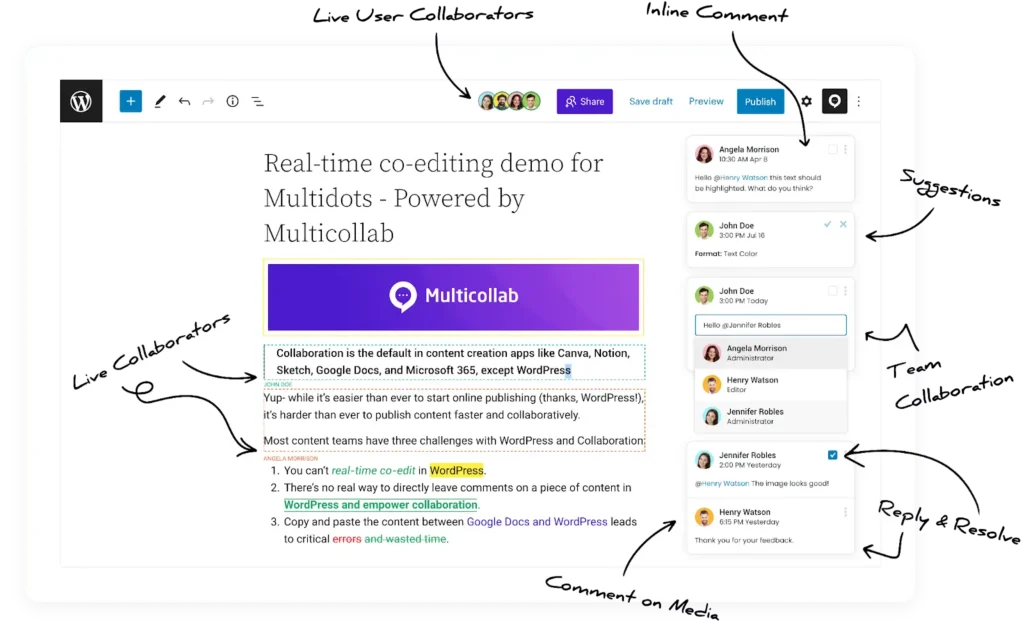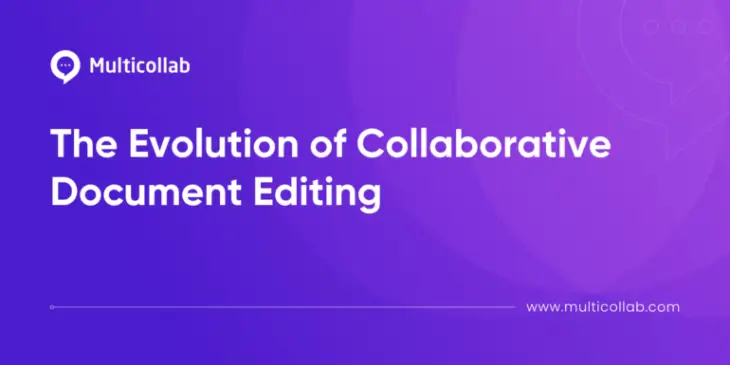Table of Contents
Collaborative document editing is a process where people work together to ideate, create, review, edit, and publish a document.
Its evolution has been nothing short of revolutionary. From the days of manuscripts to the modern era of cloud-based collaboration, the tools and methods we use to create and edit documents have undergone a remarkable transformation.
The advent of word processors in the late 20th century marked a significant leap forward in collaborative document editing. Today, remote teams across various industries rely on collaborative document authoring for the following advantages:
- Soft-testing multiple ideas at once for document creation
- Decreasing the probability of mistakes at each step of the process
- Reducing the number of review cycles required through collaborative document editing
- Getting approval to publish drafts faster
- Improving the business value of the content created
In this article, let’s look at how real-time Word document collaboration has evolved over the years and examine its advantages and disadvantages.
The Evolution of Collaborative Document Editing
Before the internet, collaborative document editing happened in person.
Professionals have been editing text documents collaboratively since companies have existed. The prevalent examples of such documents are terms and conditions, company policy, and marketing messages.
Enter the era of word processors like Microsoft Word and WordPerfect. These tools introduced track changes and comments, laying the groundwork for collaborative document editing. Version history became more manageable, albeit confined to local networks, limiting remote collaboration possibilities.
1. In-Person Collaborative Editing
Various members of the documentation team gathered in one room with a whiteboard to discuss strategies to create and refine content. Although many content teams still follow this process, it was the norm when documents were created on paper.

This method of collaborative real-time document editing offered an advantage that none of the other methods described below can — in-person interactions during content creation. This kind of collaboration leads to the accurate exchange of information without any ambiguity.
The disadvantages of in-person document editing and collaboration are that you can only work with the ones around you and for a limited amount of time as everyone needs to be available simultaneously for it to happen.
The review cycles with in-person collaborative editing of documents are usually longer because setting meetings, gathering everyone together, and clarifying issues in a room is tedious. Teams across all domains have to spend a lot of their resources to keep this process running.
2. Traditional Document Collaboration Tools
As better communication tools became available for content teams, collaborative document editing became both asynchronous and distributed. Emails and video calls changed the way team members communicate and are still used among external teams to share information.
Emails allow multiple collaborators, even those from external teams, to share ideas, suggestions, and feedback while creating documents. Collaborators can tend to the requests on their own time, facilitating asynchronous collaborative document editing.
Video calls allow synchronous document editing and collaboration which has the advantages of in-person communication. This also allows content team members across the globe to work on documents at the same time.
The efficiency of this method, however, depends on the availability of a collaborative real-time editor (such as Google Docs) for document production. Without such a tool, the collaborative document editing version control will be complicated which will make content management difficult.
Even with a collaborative real-time editor, it can be difficult for content teams to find relevant information quickly in long email chains. Also, scheduling and sitting through video calls can be frustrating while working with a distributed team.
The final disadvantage that collaborators face here is dealing with unintended information. No one wants to be a part of an email chain or a video call where they don’t need to be.
3. Third-Party Document Collaboration Software: Google Docs, Microsoft Word
Real-time collaborative editing software such as Google Docs and Microsoft Word have transformed content production workflows. Now, team members don’t need to exchange emails or sit through long video calls to collaborate on documents.
Tagging, commenting, suggesting, etc., are some of the most used functionalities of these online document editing collaboration tools. All the disadvantages of in-person collaboration, email chains, and video calls are taken care of by these popular document collaboration tools.
However, there are still some challenges that affect the document production process of the teams that rely on these tools.
WordPress content creators, for instance, have to move content from these tools to the Gutenberg Editor during the editorial process. The back and forth of content usually continue until the content is approved for publication.
Another difficulty is that these third-party collaborative document editors cannot be used to review certain types of content like videos, image carousels, CTA blocks (dynamic content), etc. This forces content creators to rely on emails and video calls to review them.
Although collaborating with external teams is simple with tools like Google Docs, it also means giving those members unrestricted access to your organizational data. This can cause issues if the permissions for document access are not managed properly through each stage of document creation.
Fortunately, the next step in the evolution of collaborative document editing takes care of the above roadblocks.
The Dawn of Online Collaboration Tools
With the advent of the internet and cloud computing, online collaboration tools like Google Docs and Dropbox Paper emerged as game-changers. These platforms offered real-time collaboration, enabling multiple users to work on the same document simultaneously, regardless of their physical location. Version control became more robust, with the ability to access previous versions and track changes seamlessly.
- The right document collaboration tool empowers teams to collaborate seamlessly, irrespective of geographical barriers.
- Features like real-time collaboration, version control, and task management streamline workflows, ensuring projects progress smoothly.
- Integration with project management apps and online collaboration tools enhances efficiency and communication among team members.
- Intuitive interfaces, robust version control, and comprehensive editing features are essential features for effective document collaboration.
- Features like tagging team members, assigning tasks, and setting due dates facilitate efficient project management. Seamless file sharing and formatting options ensure documents adhere to brand guidelines and project specifications.
Multicollab: WordPress Document Collaboration Tool
Multicollab, a WordPress plugin, has revolutionized the collaborative document editing process of teams across multiple domains. It enables Google Docs-style editorial commenting in the Gutenberg Editor allowing teams to collaborate on documents directly within WordPress. Apart from collaborative editing of documents online, you can also share feedback on videos and dynamic content blocks such as CTA boxes, image carousels, etc. This will reduce your team’s dependency on long email chains and boring video calls for exchanging feedback.
Multicollab makes your content publishing workflow 42% faster as there is no need to move content from the collaborative text editor or deal with any last-minute formatting since your editorial process is shifted to your favorite blog editor — WordPress.
Adopting Multicollab’s collaborative editing software also makes your WordPress content production workflow secure as you can invite unlimited external collaborators to share their feedback without giving them unrestricted access to your organizational data.
You can easily manage the permissions of various team members based on their roles through various phases of content development or create new roles with custom permissions based on your requirements.

Powering Collaboration with AI
Fast forward to the present, where AI-powered collaboration tools are revolutionizing document editing. Machine learning algorithms enhance productivity by offering grammar suggestions and personalized insights. Natural language processing capabilities streamline interactions, making editing more intuitive and efficient.
As technology continues to evolve, the future of collaborative document editing holds immense potential. AI-driven innovations will further enhance productivity, while advancements in online team collaboration tools will foster seamless teamwork. With the right tools and strategies in place, teams can unlock new levels of creativity and efficiency, reshaping the landscape of collaborative document editing for generations to come.
Conclusion
The collaborative document editing process will continue to evolve as new tools, technologies, and working conditions are uncovered. However, some old methods, like in-person collaboration, will still remain relevant.
The real driver of the evolution of this process depends on what document-producing teams need to ideate, create, edit, review, and publish different kinds of documents.
The document production process is now cloud-based and asynchronous which demands a versatile and scalable solution like Multicollab. This WordPress collaborative editing software changes the way teams create content by transforming the Gutenberg Editor from a blog editor to a collaborative workspace.
Want to get the most out of your WordPress document creation process?
Multicollab can help with your content approval workflow; you can start a 14-day free trial here.
FAQs:
1. What is collaborative document editing?
Collaborative document editing is a process where multiple contributors work together to create and edit a document.
2. Can multiple users edit a document at the same time?
Yes. Provided you are using tools like Multicollab and Google Docs, you can collaborate and share documents online.
3. How do I allow documents to be edited by multiple users?
It depends on how permissions are changed in your collaborative document editor.
4. Is Google Docs a collaborative software?
Yes. The Google Docs document collaboration tool is widely used.
5. What are the 3 types of collaboration?
In terms of scope and reach, team, community, and network are the three types of collaboration.
6. What happens if two people are editing a shared file at the same time?
It’s referred to as co-editing.
7. How do I enable collaborative editing?
WordPress content collaborators can enable collaborative editing by installing Multicollab.
8. How do I make an editable document for everyone?
It depends on the collaborative tool you are using. For instance, you can change the document’s permissions in Google Docs through the “Share” button at the top right corner.
9. How do I share a file and allow editing?
The functionalities of your document editing tool. For instance, you can share the file and allow editing in Google Docs by simply adding the collaborator’s email address through the “Share” button.
10. What is the best document collaboration tool?
If you publish content on WordPress, Multicollab is the best document collaboration tool for you.
11. Can multiple people work on a document in teams?
Yes. Multiple people can work on a document simultaneously with the right collaboration tool, such as Multicollab.






